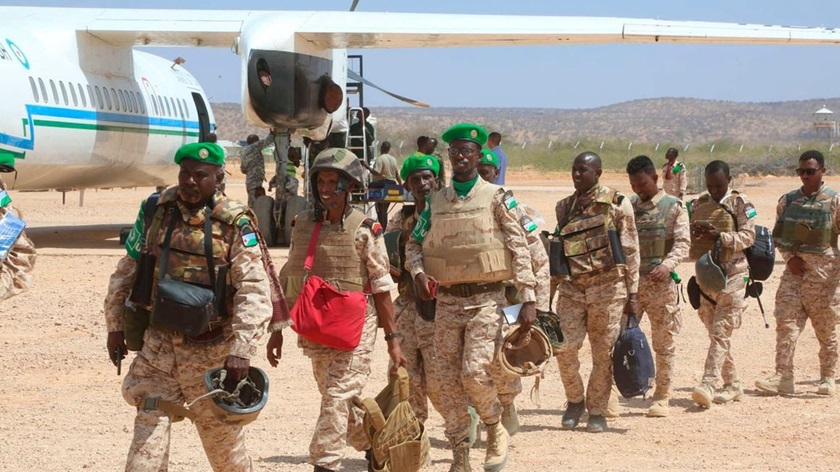Somalia’s public could be a key resource to avoid a relapse to al-Shabaab control once African Union forces leave the country later this year.
Gen Michael Langley, the Commander of the UA-Africa Command (Africom) says there are expected “opportunistic” attacks from the militant group seeking to take advantage of the gaps left by the African Union Transition Mission in Somalia (Atmis). But he argues those could be a passing cloud once people rally behind their government.

“Amidst of any ongoing Atmis drawdown, Al Shabaab is looking to exploit any resultant security vacuum through harassing attacks and security forces, and the Somali National Army realises that and they’re shoring up their defences to be able to take that amidst some of the transition or transfer of different bases,” Langley told a virtual press briefing on Thursday, days after touring the continent, including Somalia.
“So, on occasion, high-impact attacks in Mogadishu and elsewhere can result from that, but I am optimistic that the Somali federal government understands what the threat is in this transition.”
Langley met with Somalia President Hassan Sheikh Mohamud last week, and he was briefed about a “whole-of-government” approach to fight Al Shabaab and prevent a relapse once Atmis troops leave.
Liberation to stabilisation
The transition from Atmis to use of local forces is now seen as a one moving from liberation to stabilisation: Guarding territories won over from Al Shabaab from falling back into the hands of militants. That, Langley argued, requires that the public is won over, too, into the plan by the federal government as well as that of federal state authorities in the country.
“They’re seeing the value in that (collaboration). The citizens in these regions have seen the value of that. That’s where his campaign plan is most effective,” Langley said, referring to President Mohamud’s campaign to involve volunteers to back up the Somali forces against Al Shabaab.
Since he came to power in 2022, Mohamud first supported volunteer vigilantes to support national forces in weeping out Al Shabaab from various towns and villages. Then he asked financial institutions to cut out funding channels and asked the public to rename Al Shabaab in terminology that describes the group as outcasts.
But the Atmis forces are supposed to leave the country be end of December, leaving behind a gap that must be filled by local forces.
Mogadishu already asked for a staggered withdrawal, allowing Somali forces enough time to replenish their numbers. Mogadishu has also proposed a new arrangement that allows foreign forces to stay on in Somalia under a different arrangement to that of Atmis.
However, troop contributors and financiers are yet to be agreed.
“(It) is going to be a transition that is going to ebb and flow, but he is very confident that this transition is going to go smoothly, that he keeps all the tenets of all the whole of government both at the national level and the local level that they can be successful in achieving the effects against Al Shabaab.”
Somalia is facing a scenario which some analysts have warned could mimic that of Afghanistan in 2021 when US and allied forces left the country without definitive security measures. It allowed Taliban to retake authority.
This week the Acting Special Representative of the UN Secretary-General in Somalia James Swan, in a briefing to ambassadors accredited to Somalia, noted that the government has prioritised security in transition, but warned the militant group remains potent threat.
“For its part, al-Shabaab remains determined to continue terrorist attacks with little regard for the loss of civilian life,” he said.
Mohamed El-Amine Souef, head of Atmis, too acknowledged al-Shabaab’s resilience, mentioning recent assaults in parts of Galmudug State and on Atmis camps in South West State, areas where Somalia’s campaign had routed them out earlier.
“The group still retains the ability to conduct devastating attacks.”
Atmis planned drawdown that started in June 2023 saw troops reduce by 5,000. It is to continue until end of December 2024. Somalia’s Federal Government recently asked that the June 4,000 be done in two batches of 2,000 soldiers now and an equal number in September, which the African Union Peace and Security Council approved.
The request for another transition mission has obviously generated different views.
Hussein Sheikh Ali, the national security adviser who made the formal request, however, has downplayed the fears that Somalia may be overrun if Atmis leave. “The view that there is a ‘fear of Al Shabaab resurgence’ is dramatised,” he wrote on X.
The staggered withdrawal, as well as the post-Atmis mission, are matters already endorsed by current troop contributors Kenya, Ethiopia, Djibouti, Uganda and Burundi.
Hassan Ali Qaylow, a retired general in the Somali National Army, says Somalia can avoid Afghanistan-like chaos if it boosts the morale of its troops.
“If the army’s morale is low, its leadership is inappropriate and capacity is inadequate, then nothing can motivate the soldiers to fight the extremists that act under strong religious belief,” remarked the general.
“When the public believes that leaders reach high positions by corrupt means, they may prefer dictatorial rule.”
Gen Qaylow cites the regions in Somalia that enjoy relative peace, mentioning Somaliland and Puntland, as having avoided the Al Shabaab problem because leaders accepted some form of compromises and consensus, compared to spots where inter-clans warfare proves deadly.
Source: The East African

Leave a Reply